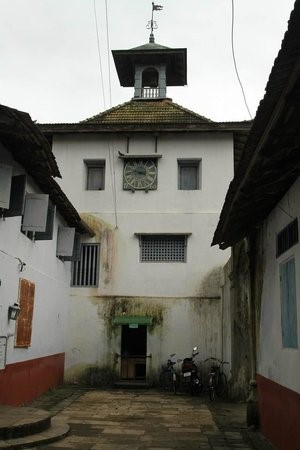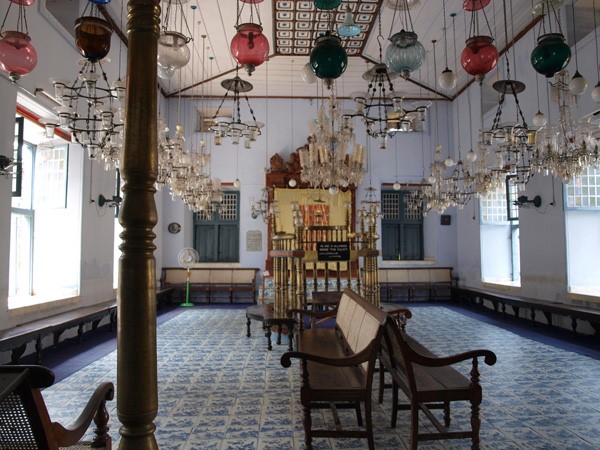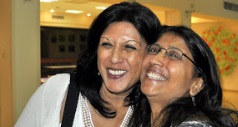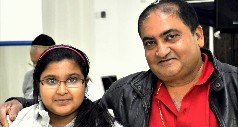PARADESI SYNAGOGUE (1568)
Synagogue Lane / Jews Street
Mattancherry
Kochi, Kerala, INDIA
This synagogue, the only functioning one in Kerala today, is an all-too-major and frequented tourist attraction and overall site, so visiting it is easy. It is open daily, except Friday afternoons and Saturdays. There is no guide available on site, and tourists are left on their own. A small entry fee is charged. A heritage plaque, prepared by the author of this website, should be available on site to read about its architecture and history. Visitors should know that two other synagogues once existed on this same street: the Tekkumbagam and the Kadavumbagam. Read those pages of this website to learn about them as well since few if any locals will know about them or help direct visitors to their nearby sites. For additional information and assistance, review cochinsyn.com and the author of this site, Jay A. Waronker at This email address is being protected from spambots. You need JavaScript enabled to view it..
To serve the needs of a Jewish community in this area that had grown in numbers by the mid-sixteenth century, in "1568" the Paradesi Synagogue was constructed in the Mattancherry area of Kochi (then called Cochin). The road that it was built on came to be known as Jew Street or Synagogue Lane, and the district as Jew Town. The Rajah of Cochin generously allotted land to the Jews in Cochin da Cima, or Upper Cochin, next to his own Dutch Palace and an adjacent conical-shaped Hindu temple (its form unique to Kerala) built to serve his royal family. By this point the membership of the Paradesi community consisted of a core that had migrated from Cranganore a day’s trip north of here then supplemented by a larger group who were relative newcomers from Europe and Western Asia. This influx to the membership of the synagogue gave it the name Paradesi, or Foreigners’ Synagogue.
Mosseh Pereyra de Paiva, a Dutch Jew who visited Kochi in "1686", declared that Spanish Jews had come to Cochin in "1512". Letters from Jesuits in South India make reference to Jews arriving from Turkey and Persia who most likely had originated in Spain and Portugal yet had been expelled by these two countries in "1492" and "1497" respectively. Others banished Jews had passed through current-day Israel, Syria, and Barbary and likewise came to settle in Cochin and became affiliated with this synagogue.
In about "1570", shortly after the final Jewish exodus from Cranganore in "1565-6" as a result of Portuguese and Moorish aggression, a Yemenite poet and traveler, Zecharia ben Sa’adya al-Dahiri, reported on his visit to Cochin. Along with Jews who had settled in the area years earlier, he found a congregation of Sephardim (a Jewish ethnic division from Europe’s Iberian Peninsula), presumably in part the Jews of the Paradesi Synagogue. A cordial relationship between the Cochin Jews and their neighbors as well as the Rajah of Cochin is also documented by the Dutch traveler Van Linschoten, who visited the area in "1589".
Though the Paradesi Jewish community had the protection and friendship of the Rajah of Cochin, they were still exposed to the enmity of the Portuguese, who established a trading post in what was to become Fort Cochin. Ultimately the Portuguese made an attack on the Jews in "1662" after they had sided with the Dutch in a skirmish for control over local territory. The Paradesi Synagogue was set on fire and partially destroyed. It is believed that other areas Kerala synagogues were attacked and damaged by the Portuguese forces at the same time.
The Jews gained security again once the Dutch were finally able to oust the Portuguese in "1665" and take control for the next one hundred thirty years until the British took charge. The Paradesi Synagogue, which had been in derelict condition during the period of Portuguese hegemony, was then repaired.
During the Dutch period, considered a good era for the Jews, the synagogue was also expanded, including the addition in the early "1760s" of the square clock tower, which is seen prominently from the street. It features faces in Malayalam, Roman, and Hebrew. At that time, another prominent feature of the synagogue -- blue and white willow pattern Chinese tiles imported by Ezehiel Rahabi -- was placed throughout the synagogue’s sanctuary floor. For centuries, a memorable design element of the Paradesi Synagogue sanctuary has been the profusion of coconut oil burning glass and metal chandeliers and fixtures hanging from the ceiling and the underside of the gallery where the unique second tebah (reader’s platform) in front of the women’s seating area is positioned.
Today the Paradesi Synagogue is the oldest functioning Jewish house of prayer not only in Kerala but in the whole of India and the rest of the British Commonwealth. The synagogue is not a single building but a unique grouping of white washed and colored thick-walled chunam (polished lime) over laterite stone (quarried locally) structures of steeply pitched roofs with deep eaves (to avoid damage from the annual monsoons), wooden lattice or strutted screens and enclosures, carved roof edges, exposed rafters, flat wall surfaces, clay tiled roofs, shuttered windows and clerestories, cusped arches at the azara’s (anteroom) and sanctuary’s entryway, tray ceiling within the sanctuary, and simple and limited detail applied at certain areas of the synagogue compound. The painted teak heickal (cabinet for storing Torah scrolls) and centrally-positioned brass lyre-shape tebah at the ground floor – two unique design features to this and other Kerala synagogues -- are the sanctuary’s most elaborately decorated elements.
In Kerala tradition, the synagogue is not made up only of the sanctuary but a complex of spaces featuring unique buildings containing a series of rooms linked or surrounded by outdoor spaces and covered places. The result is a highly dramatic, memorable, and beautiful spatial experience.

Exterior

Interior








